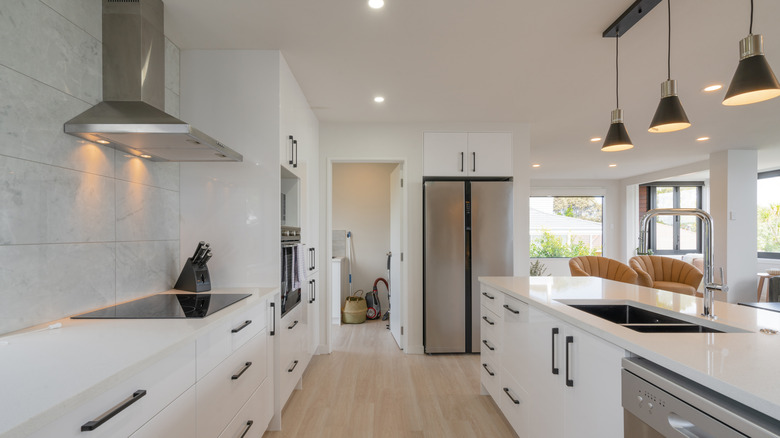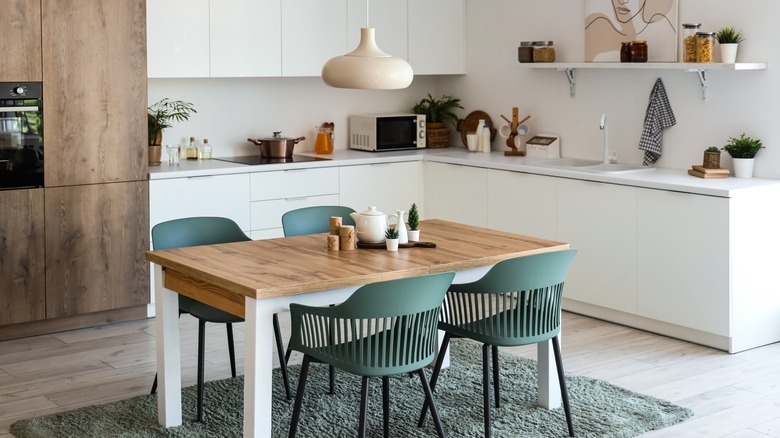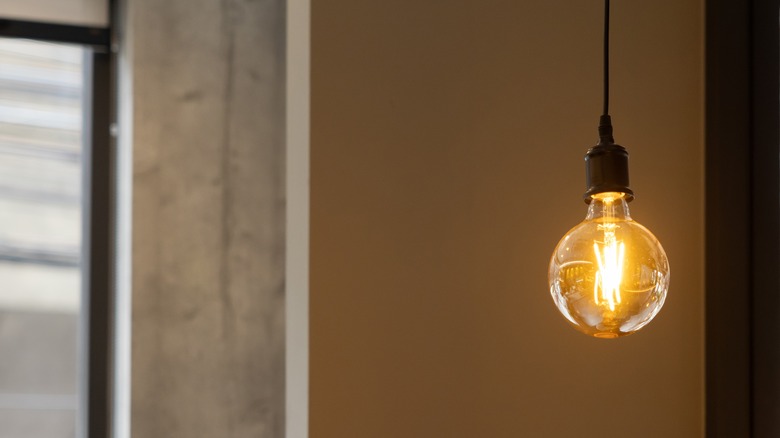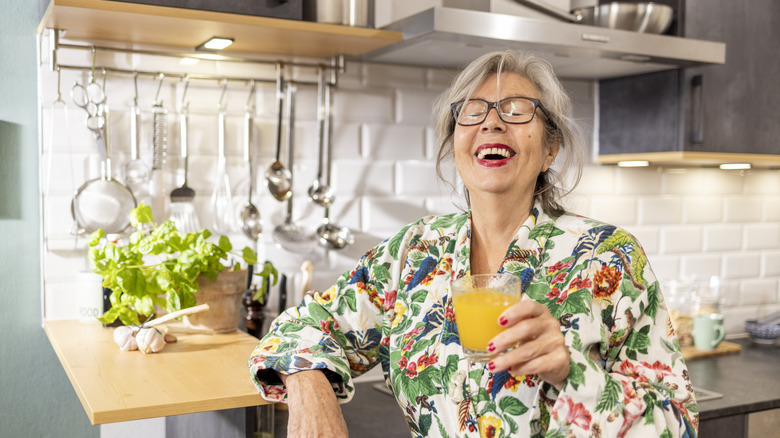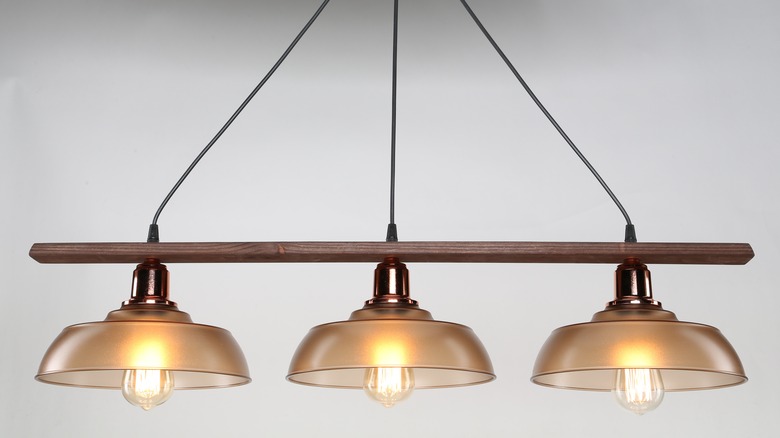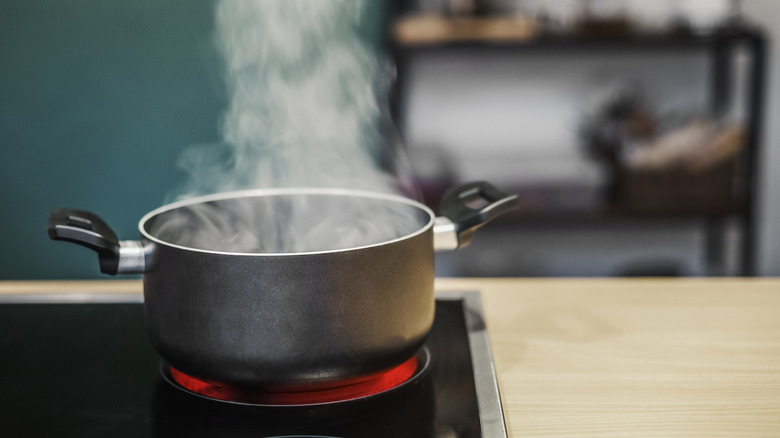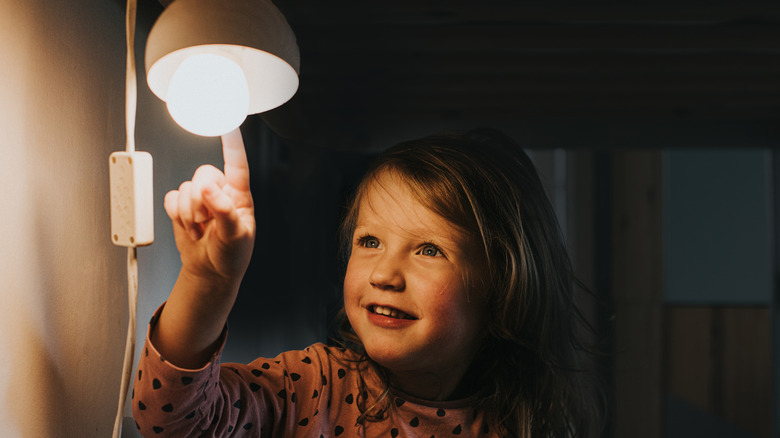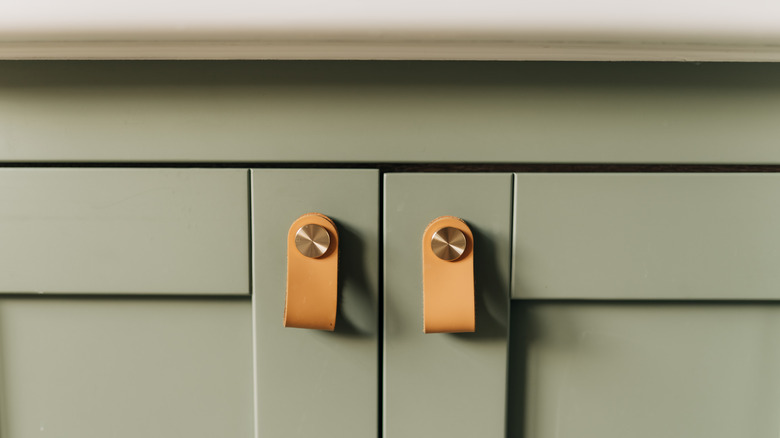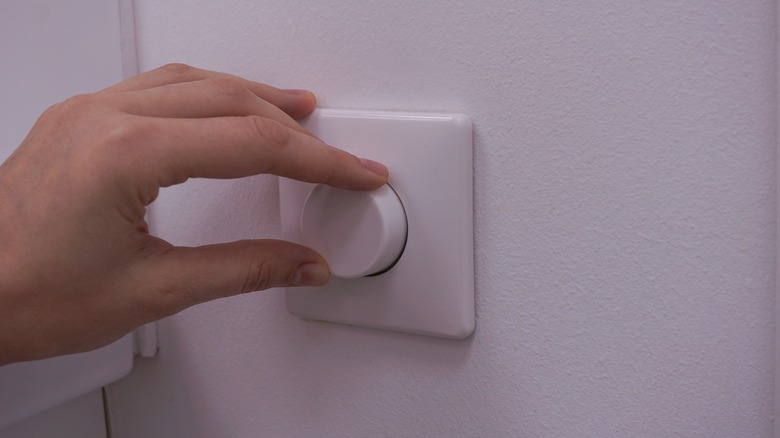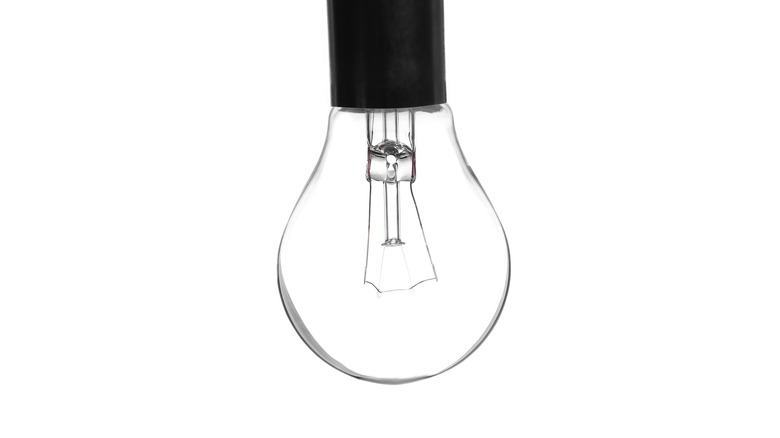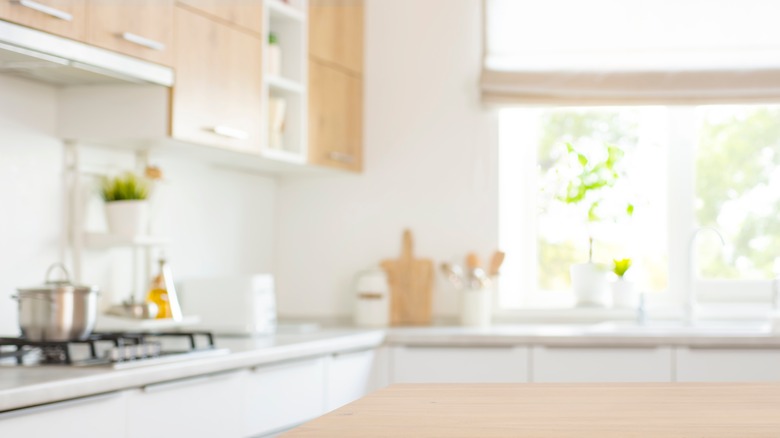15 Kitchen Lighting Mistakes Everyone Makes
We may receive a commission on purchases made from links.
Harsh lighting is no one's favorite, so why do so many homeowners and renters keep it around in their kitchens? Consider that when going out to dinner, many people seek out restaurants that are dimly lit on purpose. They feel snug and inviting (and, let's be honest, they don't highlight physical flaws the same way grocery store fluorescents do). Yet at home, kitchen lighting mistakes abound. It doesn't have to be that way.
"People spend a considerable amount on kitchen renovations but often don't budget for lighting, which is one of the most important parts," says Alina Enache, co-founder of Lamp Genius. "You need sufficient lighting for cooking and eating." Plus, she adds, lighting is an aesthetic tool that really shouldn't be overlooked.
Teri Simone, head of design and marketing at Nieu Cabinet Doors, agrees wholeheartedly. Simone, who has collaborated with Bobby Berk of "Queer Eye" and HGTV's Kortney Wilson on home projects, has noticed that lighting is about more than brightness; it's about how a space looks and feels. It can bring out the beauty of your cabinets and countertops, she says, or simply take a morning cup of coffee from functional to cozy.
Kitchen lighting, moreover, plays many roles. "You need clarity for prep, ambiance for gatherings, and subtlety for off-hours," says Justin Cornforth, CEO of Ace Home Co. "Think of lighting as part of your workflow. Done right, it makes everything from dicing onions to midnight snack runs feel better and safer." Naturally, then, you want to do it right. Here are 15 lighting mistakes to avoid.
Using only one light source
One of the most common kitchen light mistakes, says Tyler Markham, content manager at Regina Andrew Detroit, is to have only one light source. "Relying on a single overhead light to illuminate your entire kitchen is the quickest way to make a kitchen uncomfortable because each part of your kitchen is used for different purposes," he explains. "You wouldn't have only an overhead light in a bedroom, and neither would you in a kitchen because each area or time of day requires different lighting."
Rather than having a single jarring light above, you want to spread lighting throughout the room, both for form and function. This avoids dark spots under cabinets and in corners, he says, which can make the kitchen more difficult and, in some cases, more dangerous. (Looking at you, poorly lit knifework.)
Rachel Blindauer, principal interior designer of Rachel Blindauer, sums it up well: "A well-balanced kitchen lighting plan uses a combination of ambient, task, and accent lighting. The goal is to layer your lighting so that no one area is overly lit or left in shadow." To achieve this effect, she adds, you'll need multiple light sources: "A combination of pendants over an island, recessed lighting for ambient coverage, and under-cabinet lights for tasks will ensure that your kitchen is both functional and beautiful." In general, says Sydney Sims, consumer advocate for Ownerly, you should aim for two to three separate light sources of different kinds and at different heights.
Employing direct overhead light
Another of the most frequent kitchen light mistakes is to place your main source of light directly overhead. Unfortunately, explains Angie Kreller, an interior designer at Yabby, "If you rely on it completely, it can create shadows and leave some areas poorly lit." Shadows are an unpleasant effect that dampens the comfort and intimacy of the room. Shadows don't make cooking easier, either. Again, you need ambient, task, and accent lighting all at once and at different levels.
It is especially important that you don't situate the overhead lighting at your back, Alina Enache says. "When your back is turned to the light while working on countertops, a single overhead light creates shadows, making it difficult to see what you're doing," she explains. In other words, you become your biggest problem, blocking out what you're trying to see. And, Sydney Sims adds, "The kitchen tends to feel cold and eerie without softer lights."
Instead, Teri Simone says, you should bring your overhead light down somewhat, such as by using a pendant. "Think of a kitchen island as a prime example," she says. "Having pendant lights is not only pretty, but it also ... makes the worktop more directly lit, with a light source closer to your countertop than flush to the ceiling. You want lighting that adapts to how you actually live in your kitchen!"
Forgetting about low-level lighting
When folks think about lighting, they instinctively look up. In the kitchen, however, one of your prime sources of lighting should be lower. "Remember to illuminate under cabinets," says Paul Dashevsky, co-CEO of GreatBuildz. "Consider sleek track lighting you can direct where you need it most, like your cookbook. Recessed can lighting is another popular choice, and adjustable LED bulbs let you change the mood from bright and active to chill and laid back."
There are tons of options, such as stick-on LED motion sensor closet lights or rechargeable battery-operated LED motion sensor under cabinet lights. Whatever your preference, installing just a few of these will help you avoid dangerous kitchen light mistakes that leave recessed areas unlit.
Under the cabinets isn't the only place to consider additional illumination. Toe-kick lighting is also a good option. You install these lights under cabinets — typically between 2 and 4 inches from the floor — to give the room a soft glow. According to Justin Cornforth, these do more than look pretty. "They're lifesavers at night," he says. "Instead of blasting your eyeballs at 2 a.m., you get soft guidance lighting that won't wake everyone. Bonus: It helps kids and older adults navigate safely without turning on main lights."
Foregoing accent lighting
Don't forget about accent lighting. It is a must. "Accent lighting helps add depth and drama to your kitchen," Rachel Blindauer says. "For example, lighting art pieces, textured tiles, or architectural details draws attention to unique elements. LED strip lights can be installed to highlight design features while adding warmth and character."
Accent lights also help draw the lights upward, "highlighting design features without being overpowering," says Paul Dashevsky. "The key? Choosing the right brightness. Too much light washes out details. Too little makes effects disappear." Done right, though, they look excellent lining walls, countertops, and shelving. Such lights help highlight the best parts of your kitchen, Angie Kreller says, "be that the cabinets or your favorite vase."
Accent lighting needn't be applied in strips, though. You can follow Ina Garten's lighting lead and use a lamp at culinary HQ. You can use it as decoration on your kitchen island or stick it in a corner to cast a soft, grandmotherly glow into your space. Cute pieces such as the ONEWISH mushroom lamp or a candle warmer lamp will do the trick nicely.
Missing out on a statement piece
You would be remiss if you didn't include a large statement piece, which is a great way to dress up your kitchen while still putting functionality at the forefront of your design. "Improve your galley kitchen aesthetic with a stunning chandelier, sculptural pendant, or artistic sconce [that] does more than illuminate. It elevates space," Paul Dashevsky says. "Pendant lighting adds modern charm." However, you can also take your cue from vintage kitchen trends we'd love to see return, such as space race-inspired pendant fixtures. And a vintage Tiffany lamp never goes awry as a special accent piece in the kitchen.
There are, Dashevsky cautions, several things to keep in mind when installing a pendant. Avoid kitchen light mistakes such as using a too-small fixture, which will feel lost, or a too-large one that will overwhelm the space. Consider your placement carefully, too. "Centered lights bring symmetry, while off-center options create intrigue," he says.
If you do choose a lower-hanging pendant light, it is especially effective to hang it over food prep areas and islands, which creates a beautiful, gentle ambience and provides task lighting. "It also gives you the option to choose from an extensive range of stunning statement lighting fixtures that can greatly enhance your design," he says, "like the jewelry of the kitchen."
Leaving some areas of the kitchen unlit
Even with all the attention to pendant lamps, layered lighting, and accents, leaving some areas of the room unlit still numbers among the most frequent kitchen light mistakes homeowners and renters make. "We can't forget about the corners or the kitchen island," Tyler Markham says. "Everything should have light, whether it be small or not. Even light makes the space usable and even more beautiful than it would be without it." Keep your eye out for nooks and crannies. "Often, areas like the corners or countertops near the stove get overlooked," Rachel Blindauer says. "Proper lighting ensures that every nook serves its purpose efficiently without causing frustration."
One of the best ways to make sure this doesn't happen, Justin Cornforth says, is to zone your lighting. Each zone — prepping, cooking, dining, and cleaning — should have its own lighting logic, he advises. "Treat the kitchen like a studio set: layered lighting for different scenes," he says. "That way, your cleanup station isn't overlit during a dinner party, and your prep area isn't dim during rush-hour dinner."
Make sure, too, that you site your task areas correctly. "Positioning task areas, such as the kitchen island or countertops, near windows, will take advantage of daylight," Blindauer argues. Note when morning and afternoon light hit and put prep zones there.
Neglecting a night light
Among the most fixable kitchen light mistakes? Forgetting to account for what happens when the sun goes down and everyone is in bed. "[There's] nothing worse than stumbling into your kitchen late at night, groping for a light switch in the dark," Tyler Markham says. "Cabinet lights with dimmers are the perfect way to keep the ambiance of your kitchen late into the night without blinding people wandering into the kitchen for a late-night snack." (Anyone who's ever been caught in the floodlights while trying to grab a couple of Chips Ahoy! knows this feeling well.)
Toe-kick lighting or a small plug-in light will also work, Teri Simone says, adding both safety and convenience, especially if there are little ones moving around. Luckily, plug-in night lights now come in a range of stylish options. Also, many mounted microwaves have a night light setting, so you can look for that and perhaps skip the expense.
Leaving interior spaces unlit
When we think of kitchen light mistakes, or lighting in general, we tend to imagine the room itself and all the surfaces that meet the eye upon entering it. But what about the spaces that are hidden from sight, like the insides of pantries, cabinets, and drawers? You still need to know what's happening there, but too often, the light just doesn't penetrate. The good news is, adding lighting is quite simple.
"Motion-activated lights inside deep cabinets or drawers? Game changer," Justin Cornforth says. "Especially in kitchens with poor daylight, these lights keep you from blindly fishing for that one spice jar or measuring cup. They're affordable and wildly underrated." Kitchen lighting doesn't have to be glamorous, either. One of the easiest ways to upgrade your pantry and waste less food is simply to shed some light on it. Stick-on LED lighting, such as these LED puck lights, is a godsend.
Not using dimmer switches
If you're not using dimmer switches yet, you're doing yourself a major disservice. "Dimmer switches allow you to adjust lighting based on time of day, task, or mood," Rachel Blindauer says. "Whether you're hosting a dinner party and need softer ambient light or need bright task lighting to tackle cooking, dimmers offer complete control."
The best approach, says Alina Enache, is to "install switches or dimmers at the entry points so you never have to cross a dark room to turn on the lights." Dimmer switches, such as ELEGRP digital dimmer light switches, are easy to find online yourself. However, make sure you install them safely. If you don't have electrical knowledge, hire an electrician to do the wiring for you.
Using glass-globe lights near sink and stove
Be especially careful with the type of lights you choose near high-spatter areas. "Be sure that you don't use glass-globe lighting near the sink or stove," Tyler Markham says. "Water and grease splatter will make these lights look poor, and you will have to clean them constantly." He recommends powder-coated or matte finished lights near these areas. Not only will they look better, but also you won't have to clean them as often.
These aren't hard to find. You can get help at any home improvement store, or you can order an affordable option such as a pack of Sylvania100W equivalent A19 light bulbs online. There's really no excuse. It's one of the most avoidable of kitchen light mistakes, so if you have this problem, put new bulbs on your to-do list today.
Choosing a range of temperatures
One of the most aesthetically challenging kitchen light mistakes is to use bulbs with conflicting temperatures. "Whether you like white lighting or warm white lighting, all of the bulbs should be the same temperature," Tyler Markham says. "If not, it creates the same effect as having multiple paint colors in the same room." This can be jarring, so avoid it by choosing bulbs that are all warm or all cool.
"Around 2,700K gives a soft, comfortable glow ideal for kitchens," Sydney Sims says, where K stands for Kelvin and is the measurement used for color temperature. Alina Enache is fine with anything up to 3,000K and recommends you stick to a single temperature choice throughout the kitchen, even under-cabinet task lighting.
Ignoring natural light
One of the most unforgivable (and unforgiving) kitchen light mistakes is ignoring natural sources of light. "Natural light is one of the most underrated tools in kitchen design and is super easy to use to your advantage if you know how to approach it well," Angie Kreller says. "Try not to block windows with appliances or curtains." If you do have to use coverings, she says, "the best option will be to use gauzy curtains to bring more light in." This set of two 24-Inch Miulee kitchen curtain panels or this set of two 45-Inch Owenie white sheer curtain panels are both light, airy choices.
Why should you care so much about natural light? "Natural, outside light illuminates your kitchen and makes it appear larger, brighter, and lighter," Sydney Sims says. "It's free lighting that helps minimize energy consumption and looks wonderful." Making the most of it is key, Alina Enache says, so look for ways you're unintentionally working against it. "While large plants on windowsills may look attractive, they block natural light," he says. "Ideally, your kitchen should be illuminated by daylight during the day, supplemented with under-cabinet lighting only when necessary."
Thus, move everything out of the way that you can. This also includes heavy shelving and cabinetry. "Heavy shelving near windows, oversized décor elements, or crowded tabletops absorb brightness, making rooms feel darker and smaller than they should," Paul Dashevsky explains. Remove these where possible, and if you're doing a big renovation, consider a skylight. Be judicious, though. If your kitchen has lots of natural light, make sure to soften it to reduce glare.
Making mistakes with reflective surfaces
Reflective surfaces are an excellent way to increase the amount of natural light in your kitchen. For instance, mirrors make dark kitchens appear lighter by reflecting ambient and outside light back into the room and effectively increasing the overall amount. Stylish options such as the Honiway 12-inch rustic wood sunburst wall mirror or the Beautypeak 30-inch metal frame circle mirror are both fun ways to upgrade decor easily. Glass backsplashes can also help to bounce those photons around and make your cooking space brighter. However, such strategies do come with their share of kitchen light mistakes.
"Account for glare and reflection," Justin Cornforth says. "Granite, quartz, polished tile — they all bounce light differently. I've seen kitchens where the lighting was technically bright but uncomfortable because of harsh glare." He recommends seeking out areas of high glare and reducing them with frosted lenses. Gauzy curtains across overly bright windows can also help diffuse light.
Winging it with paint color
Paint color matters deeply to lighting, and choosing colors in a vacuum is common enough when it comes to kitchen light mistakes. "Look up," Paul Dashevsky recommends. "Another technique for creating the illusion of space is to draw the viewer's attention upward. Including the ceiling in the paint color is one method to accomplish this."
His approach is to select paint colors that work with your lighting, with temperatures in the same range. The colors should complement, rather than war with, your lighting — and same goes for your fixtures vis-à-vis your paint. "A cohesive design feels intentional rather than random," he says. If you need a few ideas, the book "Made for Living: Collected Interiors for All Sorts of Styles" can provide a starting point.
Dismissing the human element
The last but certainly not the least of the kitchen light mistakes is forgetting the human element. "Always remember that lighting is about people," Rachel Blindauer says. "When choosing fixtures and layouts, consider how they will affect the human experience in the space. Will they enhance the way you feel while cooking, eating, and entertaining? This is the true measure of a well-lit kitchen."
Make sure you leave room to evolve, Justin Cornforth advises, such as adding conduit or capped junction boxes during remodels for future pendants or sensors. "Want voice or motion control later? Wire for it now," he says. "Smart layouts keep options open and make upgrades cheaper down the road." That way, even if you're not ready to embrace the future quite yet, it will be easy to do so once you are.
